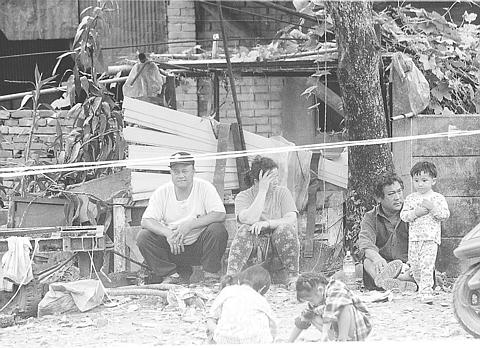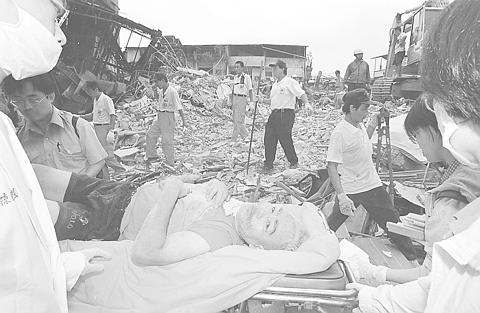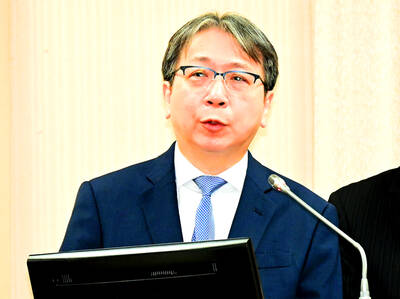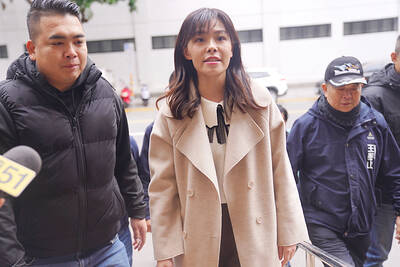As the dust settled in Puli from the worst earthquake in Taiwan this century, the town's many dispossessed residents are slowly coming to terms with the difficult future that awaits them.
Families camped outside their broken and destroyed homes have to deal with not only the fear, shock and trauma from the earthquake, but also the powerful aftershocks that continue to shake the ground around them.
Most have set up camps in open-air spaces, scattered throughout the town, in parks and in schools.

PHOTO: LIN CHENG-KUNG, LIBERTY TIMES
There is really no other place for them to go where they can feel safe, said Liao Yu-chen.
Liao was sitting in the playground of Puli's elementary school yesterday, surrounded by scores of other families facing a similar plight.
"When the quake hit, it felt like the end of the world," Liao said, describing her feelings on the night the earthquake destroyed the town.

PHOTO: CHANG YING-YING, TAIPEI TIMES
Luckily, she was able to get her family out of their home, which split nearly in two.
Now Liao, like many others, is stuck. She cannot return to her destroyed home, but is frightened to leave Puli.
"The roads are terrible -- I wouldn't go anywhere," she said. "Not only that, but aftershocks are a concern."
Just yesterday morning, Liao returned to her home to retrieve a gas cooker. But as she did, an aftershock hit again.
But yesterday, for thousands like Liao, there was a glimmer of hope. Rescue helicopters came and went several by the hour, bringing in food and water and taking away the injured.
Premier Vincent Siew (
They soon discovered that the damage in Puli is much more serious than the government initially estimated.
"It wasn't until 30 hours after the earthquake that we realized the extent of damage that had been sustained," said government spokesman Chen Chien-jen while visiting Puli.
"We were prepared, but in retrospect there was more that could have been done."
He said the government was now focusing on three immediate goals -- an urgent need to handle the bodies of those who lost their lives, shelter and tents for survivors who lost their homes, and for roads to be cleared of debris.
The government has also announced a relief budget of NT$3 billion -- as well as NT$1billion in immediate aid for Nantou, and another NT$1.5 billion for Taichung County.
Chen also said the government would be looking into the structural integrity of the affected buildings to find out why they had collapsed so easily.
Some buildings, he said, were not up to standards, pointing to the fact that many newer buildings had been destroyed.
"Those responsible should be investigated," he said.
At the Taichung veteran's hospital ambulances streamed in, bringing injured people lifted by helicopter from Puli.
A 32-year-old woman, her head wrapped in bandages, said she was in the town of Chongshi when the earthquake struck and the ceiling fell on her.
She was trapped for an hour before being rescued, but had to endure a 10-hour wait before she was taken to a hospital. She said her husband was suffering from exposure
The hospital, a mess on Tuesday as it struggled with the stream of patients, was operating normally yesterday but was packed with the injured.
In neighboring Yunlin County, US search and rescue workers combined their efforts with a local team in Touliu City, about 60km west of Puli, to save people trapped in two toppled buildings.
Workers had made contact with a 33-year old man, Hsu Tse-tai (許澤泰) a novelist, who was stuck beneath what remained of a 16-story building that had sunk five floors when it collapsed on Tuesday.
The workers were able to communicate with him, and had even fed him intravenously, as well as given him oxygen, into the small space within which he was trapped.
Last night his brother came down from Taipei to see if he was okay. There was rescue work going on the other side of the building, but his brother began to move through the rubble to where he thought the apartment would have been.
After some effort, he removed some debris, and started to call out his brother's name, and his brother called back (at 1pm yesterday), and have been trying to get him out ever since. His leg is pinned down by a slab of concrete. At press time last night, rescuers were chipping away at the slab and were confident of freeing him.
International rescue teams began arriving in Taichung yesterday.
Sccording to one member of the USAID team, the help that was being provided was, in his opinion, the best-organized that the group has encountered in its work abroad.
All three of the buildings that collapsed in Touliu were built by the same construction company, which declared bankruptcy over a year ago.
The other building had sunk deep into the ground, and the extremities of the 12-story apartment complex had split open, leaving a huge gaping hole in the middle, exposing metal rebar and concrete.
It was believed that at least four people were still trapped inside a complex that had housed 236 residents. Twenty survivors were pulled out, and another seven bodies were recovered.
But while rescue teams have managed to reach areas like Tou-liu and Puli, some areas remain cut off from the outside.
Aid has come too slowly, said Chung Lin-tong, a farmer who lives in Niomen outside of Puli.
Chung, along with his son came to Puli by motorbike to get milk powder for his newborn eight-month-old child. He and his family are living in their car outside of their country home which is no longer safe to live in. When the earthquake hit, Chung said, he had only one thought, "get my family and get out of the house."

The US government has signed defense cooperation agreements with Japan and the Philippines to boost the deterrence capabilities of countries in the first island chain, a report by the National Security Bureau (NSB) showed. The main countries on the first island chain include the two nations and Taiwan. The bureau is to present the report at a meeting of the legislature’s Foreign Affairs and National Defense Committee tomorrow. The US military has deployed Typhon missile systems to Japan’s Yamaguchi Prefecture and Zambales province in the Philippines during their joint military exercises. It has also installed NMESIS anti-ship systems in Japan’s Okinawa

‘WIN-WIN’: The Philippines, and central and eastern European countries are important potential drone cooperation partners, Minister of Foreign Affairs Lin Chia-lung said Minister of Foreign Affairs Lin Chia-lung (林佳龍) in an interview published yesterday confirmed that there are joint ventures between Taiwan and Poland in the drone industry. Lin made the remark in an exclusive interview with the Chinese-language Liberty Times (the Taipei Times’ sister paper). The government-backed Taiwan Excellence Drone International Business Opportunities Alliance and the Polish Chamber of Unmanned Systems on Wednesday last week signed a memorandum of understanding in Poland to develop a “non-China” supply chain for drones and work together on key technologies. Asked if Taiwan prioritized Poland among central and eastern European countries in drone collaboration, Lin

ON ALERT: Taiwan’s partners would issue warnings if China attempted to use Interpol to target Taiwanese, and the global body has mechanisms to prevent it, an official said China has stationed two to four people specializing in Taiwan affairs at its embassies in several democratic countries to monitor and harass Taiwanese, actions that the host nations would not tolerate, National Security Bureau (NSB) Director-General Tsai Ming-yen (蔡明彥) said yesterday. Tsai made the comments at a meeting of the legislature’s Foreign Affairs and National Defense Committee, which asked him and Minister of National Defense Wellington Koo (顧立雄) to report on potential conflicts in the Taiwan Strait and military preparedness. Democratic Progressive Party (DPP) Legislator Michelle Lin (林楚茵) expressed concern that Beijing has posted personnel from China’s Taiwan Affairs Office to its

BACK TO WORK? Prosecutors said they are considering filing an appeal, while the Hsinchu City Government said it has applied for Ann Kao’s reinstatement as mayor The High Court yesterday found suspended Hsinchu mayor Ann Kao (高虹安) not guilty of embezzling assistant fees, reducing her sentence to six months in prison commutable to a fine from seven years and four months. The verdict acquitted Kao of the corruption charge, but found her guilty of causing a public official to commit document forgery. The High Prosecutors’ Office said it is reviewing the ruling and considering whether to file an appeal. The Taipei District Court in July last year sentenced Kao to seven years and four months in prison, along with a four-year deprivation of civil rights, for contravening the Anti-Corruption